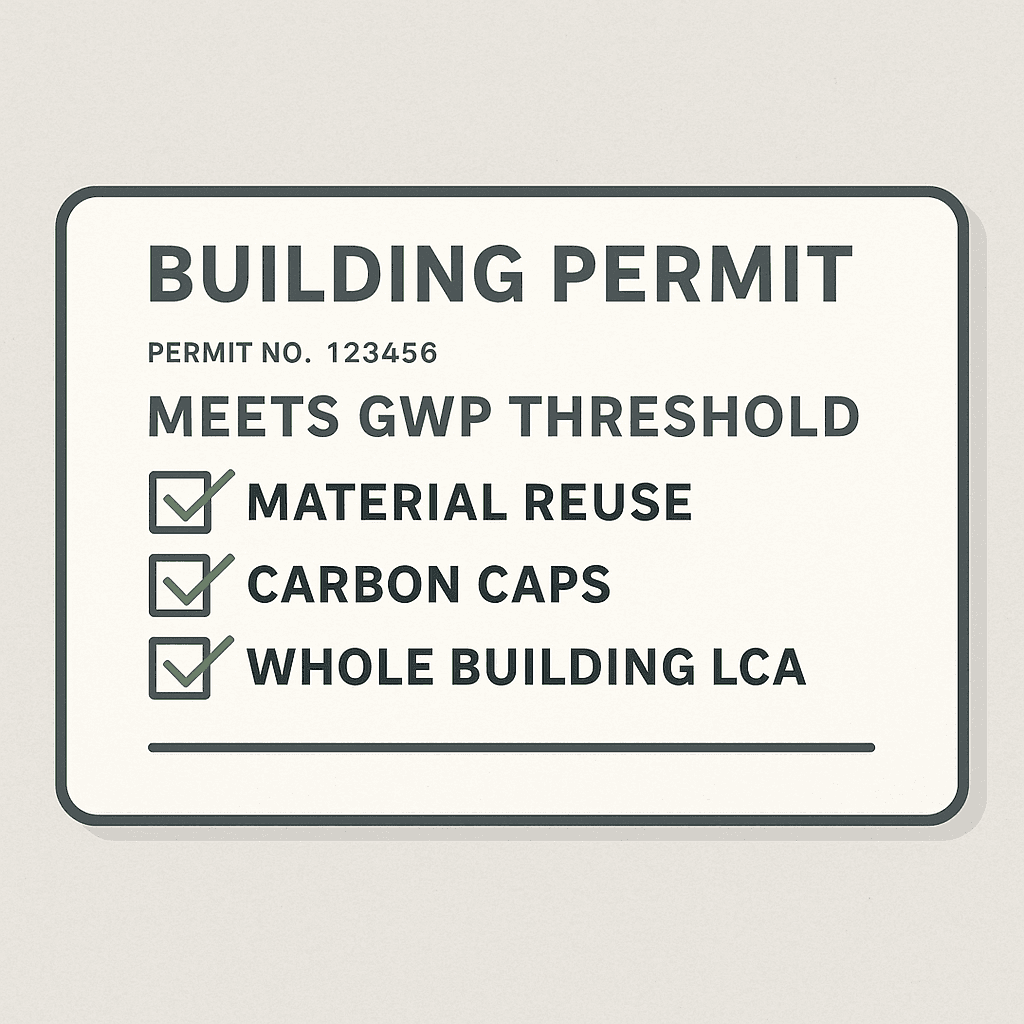New York’s Embodied Carbon Trio
A pair of twin bills—A8456 in the Assembly and S7998 in the Senate—would bake a 15 percent embodied-carbon cut into the New York State Building Code by 2030. Projects over 25 000 ft² get three routes to comply: keep and reuse almost half the existing structure, hit carbon caps on cement, steel, rebar, timber and friends, or run a whole-building life cycle assessment that proves you beat a modeled baseline (NY S7998, 2025). For manufacturers, the common denominator is trustworthy, facility-specific EPD data. No numbers, no ticket to the Empire State’s next construction boom.


A quick primer on the bills
If passed, A8456 and S7998 would instruct the Department of State to rewrite the building code by 1 January 2026 so every big project (new build, addition, or gut renovation over 25 000 ft²) tackles embodied carbon with the same urgency as energy use. The headline target starts at a 15 percent reduction from Carbon Leadership Forum 2023 baselines by 2030 and tightens to 30 percent in 2033 (S7998 §6).
Path 1: Reuse 45 percent of the structure
Design teams that keep at least 45 percent of the existing structural shell and limit square footage growth to 50 percent automatically qualify (S7998 §3). Think of it as a two-for-one: fewer truckloads to landfill and fewer new materials to buy. Manufacturers of adaptive-reuse friendly systems—façade anchors, retrofit-ready HVAC housings—get an easy talking point with architects chasing this route.
Path 2: Beat material-level carbon caps
Option 2 zooms in on cradle-to-gate (A1–A3) emissions for concrete, reinforcing steel, structural steel, engineered wood, and any other material the State adds later. Project teams must show that the summed GWP of these products undercuts the industry average by the required percentage (S7998 §4). The proof? Product and facility-specific EPDs. Generic “industry average” declarations will not cut it. If your plant still relies on an outdated, company-wide EPD, you are invisible to specifiers hunting for low-carbon numbers.
Path 3: Prove it with a whole-building LCA
Option 3 lets designers model their proposed building against a functionally equivalent reference and show the mandated carbon delta (S7998 §5). The Department can dictate scope, stages, data sources, even how biogenic carbon is counted. Missing or low-quality EPD inputs ripple through the model and can sink compliance. Translation: manufacturers without credible data risk being value-engineered out.
Timeline checkpoints
- 1 Jan 2026: Code update due
- 2030: 15 percent reduction must be met
- 2033: 30 percent reduction kicks in Dates could shift in rulemaking, but the direction is set. Better to sprint now than scramble later.
What manufacturers should do this quarter
- Inventory every product slated for New York projects in 2026–2030.
- Confirm whether each SKU has a facility-specific Type III EPD less than five years old. No? Budget for one.
- Benchmark against CLF 2023 baselines to spot products already under the threshold and those needing process tweaks.
- Capture plant-level energy, clinker ratio, scrap content, transport modes, and water metrics while they are fresh. Missing data later will stall the LCA model beleive it.
- Line up an experienced LCA partner that can shoulder data wrangling and shepherd the EPD through a reputable program operator. Speed and audit-ready completeness beat bargain rates every time.
Reading the room
Architects and owners have tasted Buy Clean and LEED v5 drafts. They will not wait for Albany to dot every i. Products with clear, third-party verified GWP numbers are already preferred on New York RFQs, according to AIA NY (2025). Manufacturers who arrive at bid time with a polished EPD portfolio will look like the adults in the room.
Bottom line for plant managers and sales teams
New York’s code rewrite flips embodied carbon from a nice-to-have into a permit requirement. The cheapest ton of CO₂ is the one you can document with confidence. Lock in your data, polish your EPDs, and the Empire State market is yours to lose.
Frequently Asked Questions
Does a product need a new EPD if the existing one was published under an expired PCR?
Not immediately. The EPD stays valid until its own five-year sunset, but the next renewal must use the latest PCR or an alternative that fits (ISO 14025).
Will the state publish exact GWP caps for concrete and steel?
Not yet. S7998 tells the Department of State to set caps in rulemaking, likely drawing from Carbon Leadership Forum 2023 baselines and updating every three years.
Can I rely on an industry-average EPD to show compliance under Path 2?
No. The bill explicitly calls for product and facility-specific declarations. Industry averages serve as the baseline you must beat.
What LCA software will New York accept for the whole-building route?
The draft text stays software-agnostic. It points to ISO 21931-1 and comparable standards, so any tool that aligns with those and outputs auditable data should pass muster.
My product ships nationwide. Do I need a New York-only EPD?
A single facility-specific EPD works everywhere, provided the declared unit and transport assumptions match the project scope. Just be ready to disclose delivery distances for the New York jobsite.
